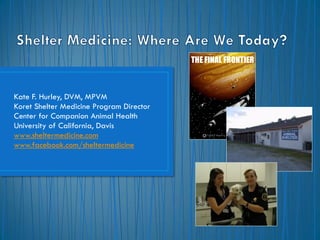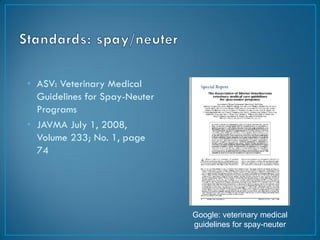Australia shelter med overview 2011
- 1. Kate F. Hurley, DVM, MPVM Koret Shelter Medicine Program Director Center for Companion Animal Health University of California, Davis www.sheltermedicine.com www.facebook.com/sheltermedicine
- 3. ’āĀ Emerging, re-emerging and zoonotic diseases Pets and ferals ’āĀ ’āĀ New pets Public and private $$$ ’āĀ ’āĀ Euthanasia
- 5. ŌĆó Help animals before they become homeless ŌĆó Help animals become re-homed ŌĆó Help animals while theyŌĆÖre homeless: practice shelter medicine
- 6. ŌĆó Individual treatment ŌĆó Inspires public support ŌĆó Improves staff and volunteer commitment ŌĆó Facilitates compliance ŌĆó Feels great
- 7. ŌĆ”must balance individual animal needs with population health
- 8. ŌĆó Infectious disease management ŌĆó Increases number of animals that survive to adoption ŌĆó Decreases suffering in the shelter ŌĆó May improve public perception
- 9. ŌĆó We had a litter of 7 puppies who seemed to have kennel coughŌĆ”Two of the seven pups got pretty sick and depressed so our clinic sent out blood samples to the lab and it came back barely positive (1:50) for distemper. The pups were 9 weeks old at the test and had been given their first shots at 6 weeks of age, three weeks earlier. I took the other five puppies to my home 8 days ago. The test came back last Friday and we euthanized the two that were in the clinic, however, they were much better that day. Well, the 5 pups I have at home are now almost completely well from the "kennel cough" , are happy playful, eating well puppies. Is this just a phase of distemper? Should I just euthanize these 5 pups now and be done with it or wait it out since they seem to be healthy (about 90% better)? We also have three adult dogs in the main kennels being treated for kennel cough. Their test also came back as a low positive for distemperŌĆ” Could these tests all be false positives or should we be better safe than sorry and euthanize all?
- 10. ŌĆó ŌĆ£We just wanted to thank you so much for helping to save our lives. Because you cared so much to help the shelter we have been happy and healthy and are awaiting our forever homes. The horrible distemper never got USŌĆ”but we and the staff are forever grateful for all your time and effort in helping us get a second chance at a happy life.ŌĆØ
- 11. ŌĆ”more than half the battle is already lost.
- 12. ŌĆó Prevention ŌĆó Vaccination ŌĆó Sanitation ŌĆó Parasite control ŌĆó Stress reduction ŌĆó Nutrition ŌĆó Air quality ŌĆó Facility design ŌĆó Population density
- 13. ŌĆó ŌĆ£Hey Doc, Before attending EXPO in Atlanta and attending your workshop many cats died. We were sick all the time. Sometimes dropping like flies. Since your workshop less than 10 cats/kittens a year. We no longer move the cat out of the cage everyday to clean. We give them play things that can be disinfected well. We have a much better air exchange. Our hand disinfectant is at least 67% alcohol. We donŌĆÖt overcrowd. We are much better about cross contamination. We are aware of the effects of stress and handling. Etc. etc. etc. All things I learned at your seminar. I will always be indebted to you.ŌĆØ
- 14. ŌĆ” a perfectly healthy population is still not the end goal.
- 15. ŌĆó OUR PRODUCTS: ŌĆó Improved shelter conditions ŌĆó Facility design ŌĆó Animal comfort ŌĆó Staff and public health ŌĆó Increased shelter adoptions ŌĆó Improve animal health and public image ŌĆó Decreased shelter intake ŌĆó Research and correct reasons for homeless and unwanted animals ŌĆó Humane communities ŌĆó Conserve resources to support preventive programs
- 16. Education Behavior Disease mgt. Foster care Decreased intake Husbandry Healthy animals Committed employees Facility design Increased adoptions Happy public Shelter support Spay/neuter Population management Legal issues
- 19. Healthy versus URI care days 4500 4000 3500 3000 2500 Care days 2000 URI Healthy 1500 1000 500 0 May August November February Month 23-33% of care days per month 10,169 cat care days/year = $$$?
- 22. Average decrease in monthly sick care days: 29% 1,132 fewer sick days summer after versus before
- 23. ŌĆó Sent: Thursday, February 25, 2010 7:50 AM To: Kate Hurley ŌĆó Subject: Feline Sickbay @ SacSPCA ŌĆó Never in my wildest dreams would I have believed I'd see the day with ONE cat in feline sickbay!!! Today is that day! And still a year later (3/8/2011)
- 30. ŌĆó Board member/advisor ŌĆó As-needed service ŌĆó Outpatient ŌĆó Shelter visit ŌĆó Surgery ŌĆó Part time/full time staff ŌĆó Multiple shelter contract ŌĆó Leadership
- 31. ŌĆó Consultation ŌĆó Outbreak control ŌĆó Shelter health ŌĆó Facility design ŌĆó Data analysis ŌĆó National outreach organizations ŌĆó Academic ŌĆó Internship ŌĆó Residency ŌĆó Masters/PhD ŌĆó Clinical instruction ŌĆó Academic/research
- 32. Shelter based research can provide knowledge to help both shelter and pet animals
- 35. www.humanealliance.org www.aspcapro.org www.acc-d.org/ www.animalsheltering.org
- 36. ŌĆó Association of Shelter Veterinarians ŌĆó www.sheltervet.org ŌĆó $5 for students! ŌĆó Continuing education at major conferences, VIN ŌĆó Shelter medicine programs: residency, research, student teaching, shelter service ŌĆó > half of U.S. vet schools ŌĆó Standardized recommendations ŌĆó 2 published textbooks ŌĆó Board specialty proposed Wiley-Blackwell
- 37. ŌĆó ASV: Veterinary Medical Guidelines for Spay-Neuter Programs ŌĆó JAVMA July 1, 2008, Volume 233; No. 1, page 74 Google: veterinary medical guidelines for spay-neuter
- 38. ŌĆó American Animal Hospital Association: shelter dog vaccine guidelines ŌĆó 2006 (update coming soon) ŌĆó Pages 19-26 Google: aaha canine vaccine guidelines
- 39. ŌĆó American Association of Feline Practitioners ŌĆó JAVMA Nov 1, 2006 Volume 229; No. 9; page 1430 ŌĆó Update coming soon Google: aafp feline vaccine guidelines
- 40. ŌĆó Published by the ASV ŌĆó Recommended minimum and ideal standards of care ŌĆó For shelters, rescues, foster parents, sanctuaries www.sheltervet.org









































